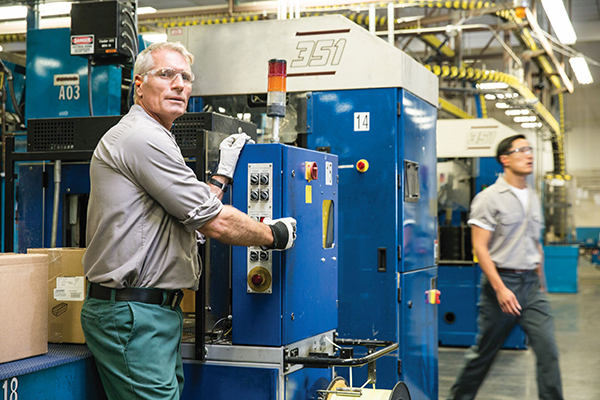There’s a positive outlook for manufacturing in 2022. But to continue growing, manufacturers will have to face evolving trends.
By Brian Kramer, Manufacturing Industry Practice Lead, The Hartford
There continues to be a positive outlook for the manufacturing industry in 2022. However, to keep growing into 2023, manufacturers will have to keep an eye on some evolving trends such as finding top talent, worker safety, and supply chain disruptions.
While the main trend for manufacturers going into 2022 was around a return to normalcy, the excitement of getting back to pre-pandemic business has been impacted significantly by a need for labor. It is also not just about finding talent, but safely integrating these individuals into the work environment.
In addition to talent shortages and a focus on employee health and wellness, manufactures should focus on business continuity planning and supply chain diversification. Here is a brief rundown on some top trends that manufactures should keep watching in 2022.

Like many industries, manufacturers are facing a talent shortage. While the manufacturing industry continues to invest in advanced technology, industrial automation, and artificial intelligence there continues to be a strong demand for skilled labor, especially as demand in some sub segments continues to be elevated. Many workers have retired or exited the workforce, while others may have been on the sideline waiting for the right opportunity to join the industry. As a result, finding, on-boarding, training, and retaining new talent continues to be a challenge.
As manufacturers work to solve the talent shortage, there should be a continued focus on employee health, wellness, and safety. Navigating pressures of meeting increased needs for production with a workforce that is operating shorthanded and fatigued can lead to preventable workplace injuries.
The challenge in not just finding talent in a tight labor market but also integrating the new teammates into the safety culture is critical. With any job there is a learning curve working in an environment that is constantly changing. Manufacturers were resilient in adapting during the pandemic as social distancing or shift work was added. Products produced during the pandemic also changed. Some manufacturers used the pandemic to plan, modernize machinery, and make upgrades to equipment for efficiency gains. Others have focused on worker safety by installing machine guarding or adding a lifting table to reduce manual material handling.
In addition, another way the manufacturing industry is working to keep manufacturing workers safe is through the Internet of Things (IoT), also known as connected devices. Companies began using IoT for a variety of reasons such as improving worker ergonomics, risk management strategies, and equipment maintenance needs. Insurers like The Hartford started working with manufacturers and other customers to find ways to integrate IoT devices as a way to leverage data to help prevent or reduce losses, ultimately lowering their cost of risk. The Hartford’s Risk Engineering team, for example, recommends manufacturers use industrial IoT to help prevent injuries and maintain worker health and wellness.
Connected devices allow for this aggregation of data that creates insights and opportunities when it comes to mitigating risk. Insurers, like The Hartford, then incorporate that data into risk management services and underwriting models. These devices help mitigate risks and claims in several ways. For example, wearable devices such as belts, clips and vests can detect biomechanical movements such as lifting and bending behaviors that are more likely to lead to injuries over time. Wearables can also track who comes on the job site, how long they are there, what areas they are in and when they leave. In a crisis, they can be used to determine where employees are on site and how to quickly get them to safety. Cameras, as another example, equipped with artificial intelligence can detect unsafe working conditions in real time alerts. This technology can be used to improve compliance with safety protocols such as wearing protective equipment, abiding by forklift zones and speed limits, and good housekeeping to prevent slip and fall hazards.
An aging workforce also creates opportunities for IoT devices, as employees may experience a decrease in flexibility, mobility, and strength capacity as they age. Other underlying health conditions may also exacerbate an injury. When an older adult gets hurt, the impact of the injury may be more severe and lengthen recovery durations, creating further obstacles to returning to work. Prevention is always better than a post-claim intervention.
It’s no secret now that the COVID-19 pandemic created unprecedented inventory and supply chain issues around the world. Political unrest in the world has intensified this issue as companies around the globe have continued to struggle with supply and inventory. Manufacturers have not been immune to this. In fact, they may be one of the hardest hit industries.
While there’s been some disruption across the board due to supply chain issues, both in terms of moving freight on water and on land, some manufacturers have been able to diversify their supply chain. Sourcing domestically, utilizing multiple suppliers or increasing raw material stock on hand continues to be the play book.
For example, it wouldn’t be uncommon for countries outside of the immediate Russian-Ukrainian conflict zone to feel the effects of the ongoing crisis. With Ukraine and Russia accounting for significant raw material supplies supporting the high tech, aerospace, energy, and agricultural industries, moderate to significant disruptions are to be expected.
There are additional factors impacting manufacturer supply chains as well. This includes the length of time it takes to unload cargo ships at ports and a truck driver shortage to move goods once they are on land. While there is such a backlog across the supply chain, it continues to improve slowly. It is just going to take some time as productivity levels in manufacturing are rising, but not as quickly as needed because delays with goods transportation are a main factor in supply chain disruptions.
These issues highlight the necessity for the manufacturing industry to review its supply chain on a continuous basis. Beyond supply chain, there is also a need to contemplate business interruption losses. Consider what happens in the event of a fire in a critical piece of machinery. What is the lead time and cost to source parts for that machine and or replace that machine given the global environment? What if a supplier in which a manufacturer is dependent in goods or materials has a fire? The need to contemplate a business interruption or a contingent business interruption event is critical.
While it’s impossible to predict the future, planning for the worst can help manufacturers be better prepared in case of an emergency. Professionals at The Hartford recommend that manufacturers and businesses have a business continuity plan that includes assessments to identify risks and key business areas and critical functions, preparedness against emergencies, response to know how to respond to emergencies or crises, and recovery strategies to reduce losses and bring your operations back online.
Despite these trends manufacturers have to face in 2022, businesses have a reason to be optimistic. It will take time for things to go back to normal and for manufacturers to work through the effects brought on by the pandemic. The impact continues to be largely from the disruptions in supply chain or the delay in moving goods, as well as the shortage of workers. However, as these trends continue in a post-pandemic world, there is excitement around returning to what life looked like prior to the pandemic. It will simply take time to get back to a sense of normal and work through current backlogs.

About The Author
Brian Kramer leads the manufacturing industry portfolio team at The Hartford. He joined The Hartford in 2006 and took on roles of increasing responsibility in underwriting and sales. He holds a bachelor’s degree from Fordham University.
The Hartford Financial Services Group, Inc., (NYSE: HIG) operates through its subsidiaries, including the underwriting company Hartford Fire insurance Company, under the brand name, The Hartford®, and is headquartered in Hartford, CT. For additional details, please read The Hartford’s legal notice at www.thehartford.com. The information provided in these materials is intended to be general and advisory in nature. It shall not be considered legal advice. The Hartford does not warrant that the implementation of any view or recommendation contained herein will: (i) result in the elimination of any unsafe conditions at your business locations or with respect to your business operations; or (ii) be an appropriate legal or business practice. The Hartford assumes no responsibility for the control or correction of hazards or legal compliance with respect to your business practices, and the views and recommendations contained herein shall not constitute our undertaking, on your behalf or for the benefit of others, to determine or warrant that your business premises, locations or operations are safe or healthful, or are in compliance with any law, rule or regulation. Readers seeking to resolve specific safety, legal or business issues or concerns related to the information provided in these materials should consult their safety consultant, attorney or business advisors. All information and representations herein are as of June 2022.
Reported results are based on Hartford’s past performance and not a guarantee of future results. Individual account results may vary.
Scott Ellyson, CEO of East West Manufacturing, brings decades of global manufacturing and supply chain leadership to the conversation. In this episode, he shares practical insights on scaling operations, navigating complexity, and building resilient manufacturing networks in an increasingly connected world.